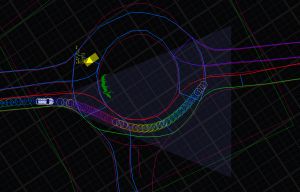Nearly 44 million private cars are registered in Germany. Indi-vidual mobility is considered an element of the quality of life by many people. However, 300,000 traffic accidents with many casualties occur every year. Autonomously driving vehicles that coordinate their activities with the help of sensors are to enhance the safety of road traffic in the future. The new priority programme “Cooperatively Interacting Automobiles” funded by the German Research Foundation (DFG) will now pool the work of various research institutions in this area. This programme is coordinated by Professor Christoph Stiller, Karlsruhe Institute of Technology (KIT).
The negative aspects of individual mobility do not only include nu-merous traffic accidents, but also environmental pollution by noise and exhaust gases, high fuel consumption, and traffic jams. Moreo-ver, demographic change calls for maintaining the mobility of elderly people. After having lost their fitness to drive, they are frequently dependent on inadequate public passenger transport systems or support by social services.
“Recent developments in the automotive sector open up options for solving these problems,” Professor Christoph Stiller, Head of KIT’s Institute of Measurement and Control (mrt), says. All over the world, research groups are developing automatic vehicles, also at the KIT. “Using sensors and digital maps, they create a model of the vehicle environment and can plan and realize appropriate driving maneuvers also in complex and safety-critical situations, much quicker than it can be done by a driver.“ Moreover, the technology for communi-cation of vehicles with each other and with the infrastructure ad-vances rapidly. The corresponding systems (Car2X communication systems) may be expected to be part of the standard equipment of cars in a few years from now. “Cooperatively interacting automobiles have the potential to increase traffic safety, to improve traffic flow, and to reduce environmental pollution and fuel consumption. Hence, they are of considerable relevance not only from the scientific point of view, but also from the society’s perspective,” Stiller explains.
The DFG priority programme “Cooperatively Interacting Automo-biles” will bundle these separate developments in an interdisciplinary manner and establish the scientific basis for an entirely novel type of automatic cooperative traffic. Automatic coordination of the vehicles with each other is to ensure planning and safe execution of vehicle movements within milliseconds even in critical situations. Drivers would not be able to do so due to their limited communication and reaction capacities. Wireless communication will allow for driving maneuvers on smallest space with a far-reaching perception range for information and communication systems of other vehicles.
In total, the DFG has adopted 16 new priority programmes to study basic scientific problems in highly relevant or emerging research areas in the next years. The new priority programmes to be funded were selected from a total number of 72 concepts by the Senate of the largest research funding and central self-administration organi-zation for science in Germany at the spring meeting in Bonn in late March this year. Work under the priority programmes will start in 2015.
More information:
http://www.dfg.de/service/presse/pressemitteilungen/2014/pressemitteilung_nr
The Mobility Systems Center pools KIT activities relating to vehicle technology. Presently, 40 KIT institutes with about 800 employees are working on methodological and technical fun-damentals for tomorrow’s vehicles. It is their objective to de-velop concepts, technologies, methods, and processes for future mobility considering the complex interactions of vehicle, driver, traffic, and society.
In close partnership with society, KIT develops solutions for urgent challenges – from climate change, energy transition and sustainable use of natural resources to artificial intelligence, sovereignty and an aging population. As The University in the Helmholtz Association, KIT unites scientific excellence from insight to application-driven research under one roof – and is thus in a unique position to drive this transformation. As a University of Excellence, KIT offers its more than 10,000 employees and 22,800 students outstanding opportunities to shape a sustainable and resilient future. KIT – Science for Impact.

